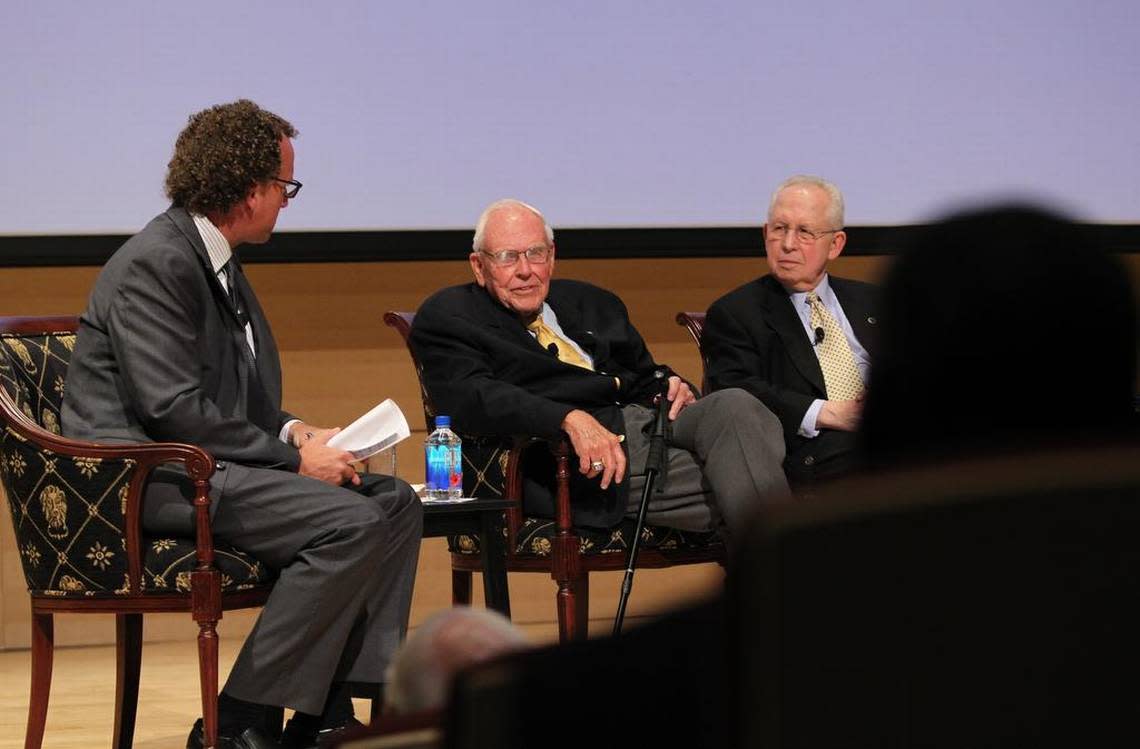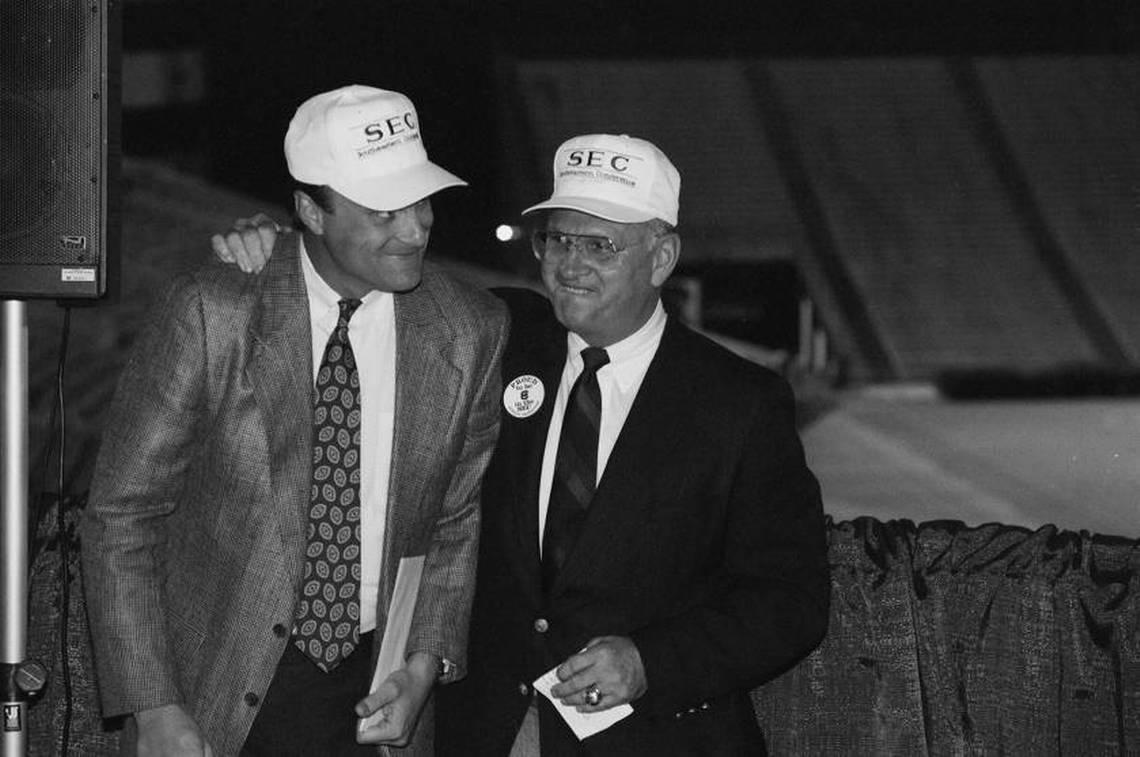How SEC landed on South Carolina, Arkansas for first league expansion 30 years ago
Thirty years brings plenty of change in value. The almighty dollar has ebbed and flowed in that time. What was $50 in 1992 is worth roughly $100 in 2022, if adjusted for inflation.
That’d get you a nice dinner in Columbia. Or, perhaps, a movie and a drink afterward. How about a few days worth of groceries?
Three decades ago, $50 got South Carolina into the Southeastern Conference.
“I’m not even sure we ever collected that,” former SEC Commissioner Roy Kramer quipped of the league’s annual dues at the time.
South Carolina opens league play on Saturday against an Arkansas program that joined the Gamecocks in starting SEC play 30 years ago this fall.
The former cross-division rivals have played 23 times in that span, though they’ve met only once since 2013.
None of the players participating in Saturday’s contest were alive when South Carolina and Arkansas officially shifted from football independence and the Southwest Conference, respectively, into the SEC. Gamecocks head coach Shane Beamer was only 15 years old when USC played its first-ever league game in 1992.
But amid new waves of conference realignment, those who were part of the SEC’s first major wave of expansion since the league’s inception in 1933 reflected on the decisions that led to the joint additions of South Carolina and Arkansas and the inextricable link between the two schools.
“It was important for the future, especially for scheduling and monetarily — the money the league would bring,” ex-South Carolina head coach Sparky Woods told The State. “And at that time, we had no idea how right we were.”
The beginnings of SEC football expansion
Woods’ memories are fuzzier these days. Thirty years of aging will do that.
But sprinkled amid a coaching career that spans six different decades are vivid visions of the hotel boardroom in Kansas City, where South Carolina administrators and SEC officials met, beginning in 1990, to discuss USC’s possible inclusion in the league.
“They wanted to feel that we were serious about running a good, clean program and all that,” Woods said. “And both (President) Dr. (Arthur) Smith and (Athletic Director) King (Dixon) were fantastic at that.”
Internal discussions about expansion began well before Woods’ meeting with league officials — and even prior to Kramer’s appointment as commissioner earlier that year.
Presidents within the SEC floated the idea of adding members in the previous year or two, though nothing official was enacted. A vote to consider expansion came after the league’s annual spring meetings in 1990.
Kramer makes clear the SEC had no intention of courting teams on its end. If a school was interested, the ball was in its court.
“I’ll be honest with you, Arkansas and South Carolina, from the very beginning, seemed to express the most interest,” Kramer said.
South Carolina fit the league geographically, but off-field issues gave the SEC brief pause. The school was embroiled in controversy following the sudden death of head coach Joe Morrison in 1988 and a steroid scandal that rocked college football under his watch — a stain on the program those around Columbia still rarely discuss.
Woods took the job ahead of the 1989 campaign with the promise of cleaning up the football program. In theory, he’d rekindle the magic of Morrison’s 10-win 1984 season the right way.
“We were on an indefinite probation when I came there,” Woods explained. “And they (the SEC) had to believe that we weren’t going to break the rules. We had to convince them of that.”
A shortlist mention didn’t guarantee South Carolina and Arkansas inclusion in the SEC.
Florida State was the golden goose in the realignment race of the early 1990s. Bobby Bowden’s Seminoles were in the midst of 14-straight seasons of 10 wins or more. FSU was also just a few years shy of claiming its first national title in 1993.
Other schools had their names floated for inclusion. Georgia Tech — a founding member of the SEC that left the league in 1961 — had some loose and unofficial interest through back channels about potentially rejoining, SEC executive associate commissioner/CFO Mark Wommack told The State. Miami and Clemson were also potential geographic fits.
Still, the SEC landed on South Carolina and Arkansas.
“There were a lot of teams that were either significant discussions or just kind of gauging interest,” Wommack said. “But at the end of the day, when you looked at it, the interest South Carolina had in coming into the league, seeing what they offered and how they fit into the league was certainly something that our people were excited about when the offer was extended.”

How South Carolina, Arkansas landed in realignment talks
Information moved slower in 1992. A few keyboard strokes and a click of a button couldn’t send a scoop to thousands of internet sleuths.
Motions to move South Carolina and Arkansas to the SEC weren’t exactly done under the cover of darkness, but university administrators and league officials operated slightly below the radar as inklings regarding expansion leaked out in newspapers nationwide.
The first domino fell when Penn State kicked off the realignment carousel, announcing its intention to join the Big Ten in December 1989.
Kramer’s credo to explore expansion in the spring of 1990 was followed by officially poaching Arkansas from the SWC on Aug. 2 of that year.
“They were the only non-Texas school in that conference and it was sort of Arkansas vs. the world.” Kramer said. “… How much they thought about it, I don’t know. But I know as soon as we made the announcement (about potentially expanding), their clock started to run.”
Motivated, at least on some level, by a desire to create a conference championship game, the SEC needed one more team.
NCAA bylaws at the time allowed for leagues to hold a postseason game to determine their champion, but necessitated a conference have 12 member institutions to do so. The format had worked at the Division III level, but no one had ever attempted it — and the divisional structure that would come along with it — in big-time college football.
Kramer wanted to be the first.
“I’ll never forget the first year (of the championship game) Alabama and Florida were in it, and I remember Coach (Gene) Stallings saying, ‘Well, this was a terrible idea. We’ve had an undefeated season with 12 wins and now we have to play another game,’” he recounted through a laugh.
Even at 92 years old, Kramer keeps his cards close to his vest, opting not to disclose which schools were involved in the behind-the-scenes jockeying for that 12th slot.
Florida State was the obvious choice, before it sided with the ACC on Sept. 20, 1990. That shift even prompted a war of words from then-Alabama President Dr. Roger Sayers insisting the league never actually made a formal offer to the Seminoles’ brass.
“It seemed to us that Florida State wasn’t all that interested in becoming a member of the SEC,” Sayers said at the time, according to the South Florida Sun Sentinel. “We want schools who are eager to become members of the SEC. Since no formal offer had been made, we decided to remove Florida State from further consideration for membership. It was a consensus.”
“I think Coach Bowden felt that he could win more games, frankly, in the ACC,” Woods said recently. “And so we were kind of at (the mercy) of whatever he decided.”
The Tampa Bay Times reported three days later the SEC had narrowed its decision to South Carolina and Miami.
The wheels in Columbia were well in motion.

South Carolina gets the call
It was mid-morning on Sept. 25, 1990 when Johnny Gregory — then a special assistant to the president — popped into Smith’s office.
The USC president was in the middle of a call with Kramer, speaking just loudly enough for Gregory to overhear the tail end of the call.
“If I call you back at 5 o’clock with an invitation, will you accept?” Kramer queried.
“Most certainly,” Smith assured. “I have full authority from the board to say, ‘Yes,’ to that question.”
“I apologized to President Smith,” Gregory told The State recently. “And he said, ‘No, no, no, no. I’m glad you were here. You’re gonna be a witness to this telephone call one day, because if somebody says something happened that didn’t happen, you’re my witness.’ ”
Kramer called back shortly thereafter. He had one more question.
“Should we make an announcement?” Kramer asked.
“Well, I’ll tell you this, as long as some of my board members know, we better do it right now or it’s going to be out anyway,” Smith said, only half-joking.
South Carolina alerted local reporters that a press conference was being called at Williams-Brice Stadium. Fans were invited to attend. Several thousand showed up.
Kramer and his staff quickly boarded a charter flight from SEC headquarters in Birmingham bound for Columbia.
By night’s end, the slew of SEC and South Carolina administrators gathered on the spiral concourse of Williams-Brice Stadium for an official announcement.
“It’s certainly hard to believe it’s that long ago,” Wommack said. “But it’s been a terrific relationship between the SEC and South Carolina and they’ve been a terrific member of the league.”
South Carolina and Arkansas would begin playing football in the SEC in 1992, though their smaller-budget sports started league competition the year prior.
On Saturday, the Gamecocks and Razorbacks will meet in the first game of their respective 2022 SEC football slates.
Tickets are still available for the contest in Fayetteville. A pair of seats in section 501, Row 10 — the furthest corner of Donald W. Reynolds Razorback Stadium — will cost you $47.99 on the secondary market, including fees.
Fifty bucks sure doesn’t go as far as it used to.
SEC titles for South Carolina Gamecocks
——Regular season or tournament——
Women’s basketball: 12
Women’s soccer: 5
Baseball: 4
Softball: 3
Women’s outdoor track: 3
Equestrian 2
Women’s tennis: 2
Women’s golf: 1
Men’s basketball: 1
——SEC divisional titles——
Baseball: 7
Softball: 4
Men’s basketball: 2
Football: 1
USC’s SEC history
▪ Sept. 25, 1990: South Carolina officially accepts invitation from the Southeastern Conference to join the league.
▪ July 1, 1991: South Carolina officially joins the SEC
——First Gamecock sporting events in the SEC——
▪ Oct. 4, 1991: South Carolina vs. Alabama volleyball (UA, 15-13, 14-16, 15-6, 15-11)
▪ Oct. 24, 1991: South Carolina vs. Alabama swimming (USC men, 143-98; UA women, 136-100)
▪ Dec. 3, 1991: South Carolina vs. Kentucky women’s basketball (UK, 75-63)
▪ Jan. 4, 1992: South Carolina vs. Kentucky men’s basketball (UK, 80-63)
▪ Feb. 2, 1992: South Carolina vs. Kentucky women’s tennis (UK, 5-4)
▪ Feb. 16, 1992: South Carolina vs. Vanderbilt men’s tennis (USC, 5-3)
▪ March 21, 1992: South Carolina vs. LSU baseball (LSU, 4-1)
▪ Sept. 5, 1992: South Carolina vs. Georgia football (UGA, 28-6)
▪ Sept. 8, 1995: South Carolina vs. Vanderbilt women’s soccer (VU, 3-0)
▪ March 15, 1997: South Carolina vs. Florida softball (USC, 5-0)
▪ Oct. 4, 2012: South Carolina vs. Auburn equestrian (USC, 10-9)
